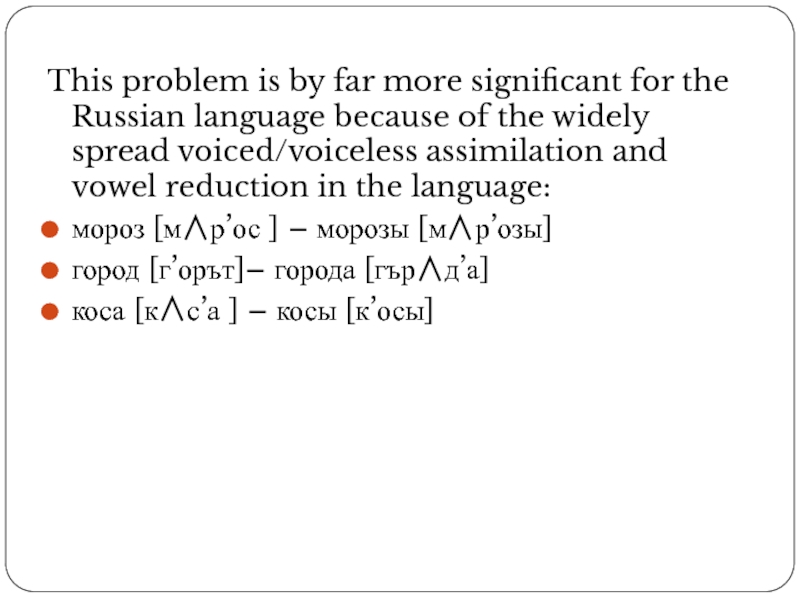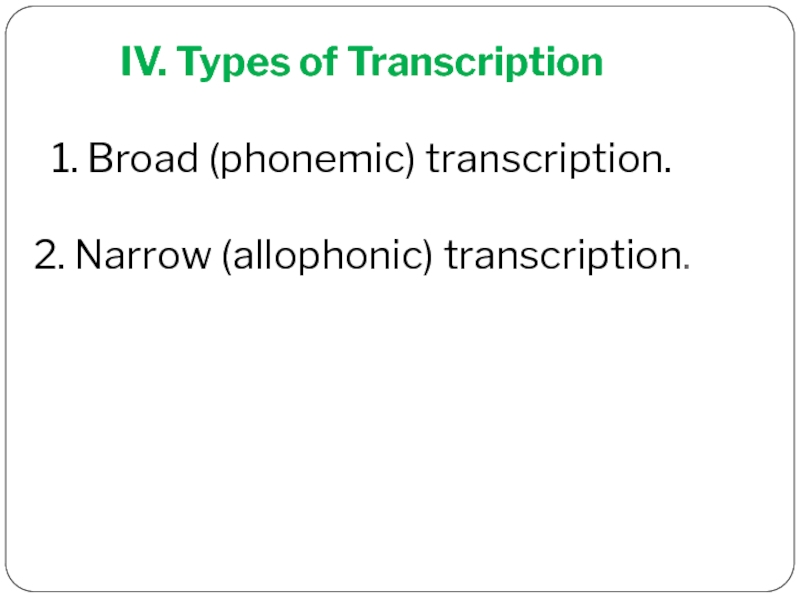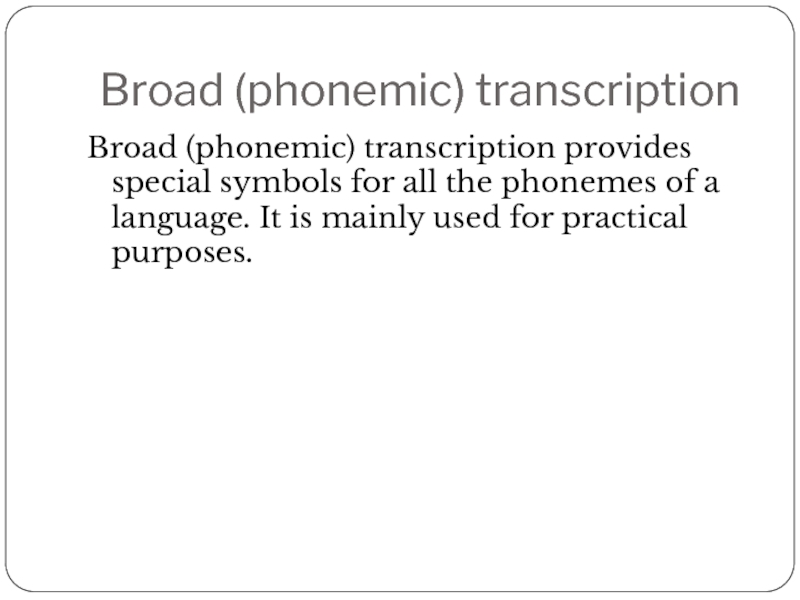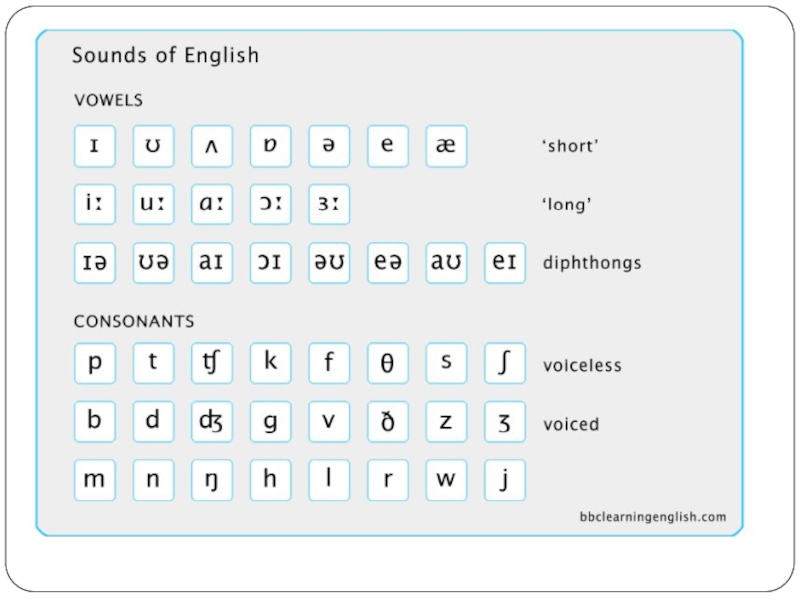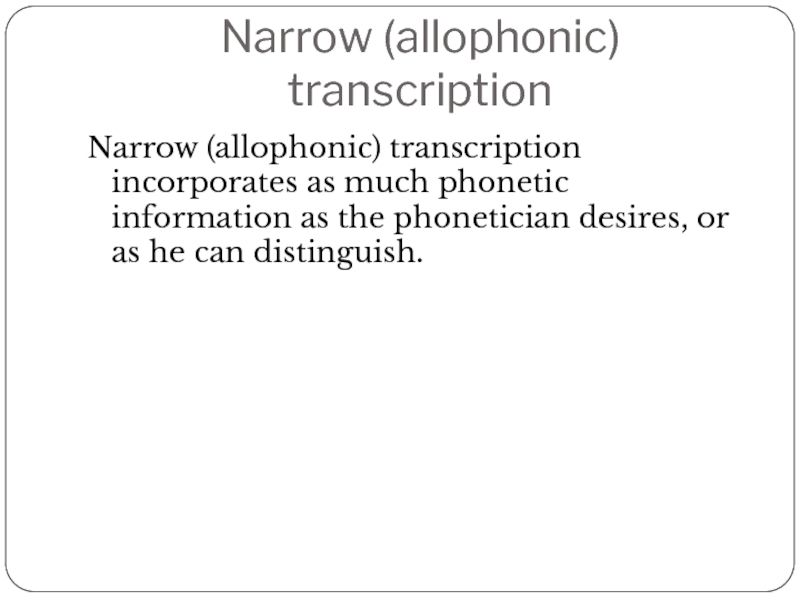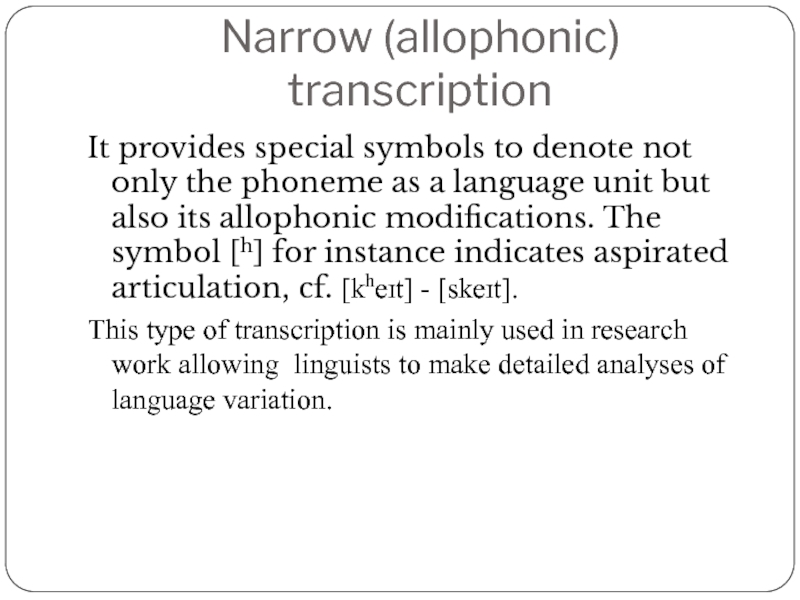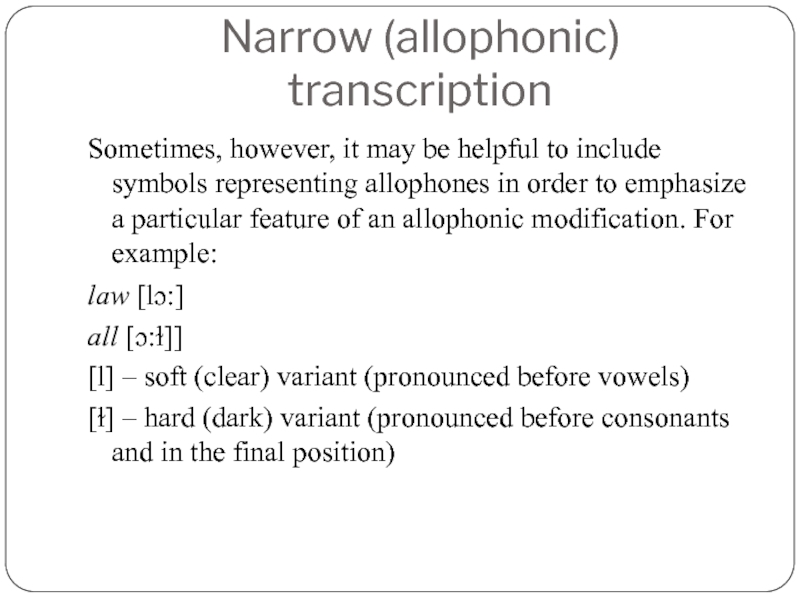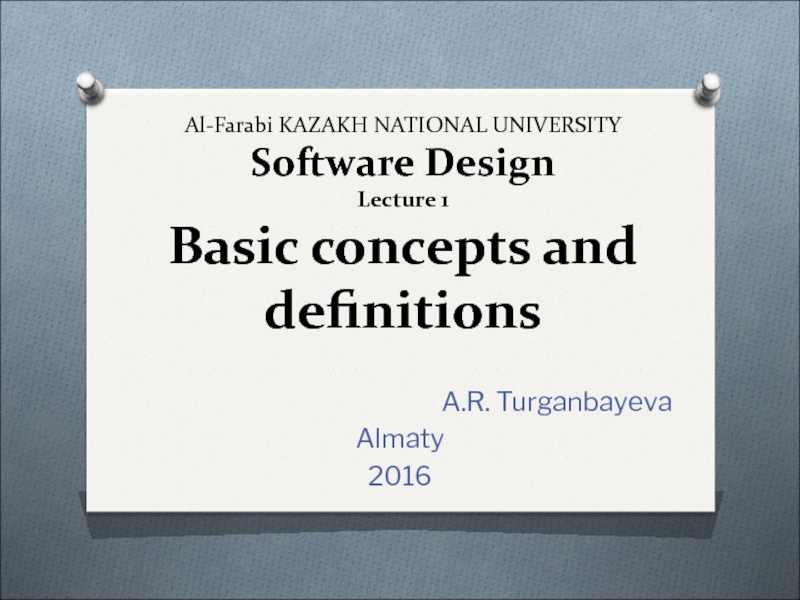- Главная
- Разное
- Дизайн
- Бизнес и предпринимательство
- Аналитика
- Образование
- Развлечения
- Красота и здоровье
- Финансы
- Государство
- Путешествия
- Спорт
- Недвижимость
- Армия
- Графика
- Культурология
- Еда и кулинария
- Лингвистика
- Английский язык
- Астрономия
- Алгебра
- Биология
- География
- Детские презентации
- Информатика
- История
- Литература
- Маркетинг
- Математика
- Медицина
- Менеджмент
- Музыка
- МХК
- Немецкий язык
- ОБЖ
- Обществознание
- Окружающий мир
- Педагогика
- Русский язык
- Технология
- Физика
- Философия
- Химия
- Шаблоны, картинки для презентаций
- Экология
- Экономика
- Юриспруденция
Phonological analysis of speech sounds. Lecture 5 презентация
Содержание
- 1. Phonological analysis of speech sounds. Lecture 5
- 2. The Phoneme, its Definition, Aspects and
- 3. I. The Phoneme, its Definition, Aspects
- 4. “Phoneme” is used to mean “sound”
- 5. So, in connected speech a sound is
- 6. DEFINITIONS OF THE PHONEME L. Shcherba: “A
- 7. DEFINITIONS OF THE PHONEME V. Vassilyev:
- 8. The phoneme is a minimal abstract
- 9. Allophones (or variants) of a
- 10. THE PHONEME [t] and its allophones Stongly
- 11. FUNCTIONS OF THE PHONEME The distinctive function.
- 12. FUNCTIONS OF THE PHONEME 2. The constitutive
- 13. FUNCTIONS OF THE PHONEME 3. The recognitive
- 14. In actual speech the constitutive, distinctive
- 15. II. Some Aspects of the Phoneme Theory.
- 16. L.V. Shcherba (1880-1944) His early definition was
- 17. N.S. Trubetzkoy (1890-1938) Head of the Prague
- 18. Ferdinand de Saussure (1857 – 1913) The
- 19. D. Jones (1881–1967) “The phoneme may be
- 20. III. Sound Interchange Sounds variations in the
- 21. Sound interchange can be defined
- 22. [mæn]- [men] – the alternates are
- 23. The types of sound interchange: 1.
- 24. 2. Diachronic causes → historical alternations
- 25. Phonetic alternations, as a rule, have no
- 26. e.g. [s] is pronounced after voiceless consonants
- 27. e.g. [d] is pronounced after voiced
- 28. Another case of alternations commonly used is
- 29. Historical alternations, on the contrary, always have
- 30. An alternation of sounds may be
- 31. This problem is by far more significant
- 32. IV. Types of Transcription 1. Broad (phonemic) transcription. 2. Narrow (allophonic) transcription.
- 33. Broad (phonemic) transcription Broad (phonemic) transcription provides
- 35. Narrow (allophonic) transcription Narrow (allophonic) transcription incorporates
- 36. Narrow (allophonic) transcription It provides special symbols
- 37. Narrow (allophonic) transcription Sometimes, however, it may
- 38. This is it ☺
Слайд 2
The Phoneme, its Definition, Aspects and Functions.
Some Aspects of the Phoneme
Theory.
Sound Interchange.
Types of Transcription.
Sound Interchange.
Types of Transcription.
Слайд 3
I. The Phoneme, its Definition, Aspects and Functions.
.
Phonetics studies sounds
as articulatory and acoustic units.
Phonology investigates them as units which serve people for their communicative purpose.
Phonology investigates them as units which serve people for their communicative purpose.
Слайд 4
“Phoneme” is used to mean “sound” in its contrastive sense.
“Allophone” is
used for sounds which are variants of a phoneme; they usually occur in different positions in the words (i.e. in different environments) and they cannot contrast with each other, nor be used to make meaningful distinctions.
Слайд 5So, in connected speech a sound is generally modified by its
phonetic environment: by neighbouring sounds, by the position it occupies in a word or in an utterance, by the stress, speech melody, tempo of speech.
[p] port – initial position (strong aspiration)
sport– after [s] (the loss of aspiration)
top – final position
[p] port – initial position (strong aspiration)
sport– after [s] (the loss of aspiration)
top – final position
Слайд 6DEFINITIONS OF THE PHONEME
L. Shcherba:
“A phoneme is a functional, material and
abstract unit… It’s a dialectal unity of these three aspects because they determine one another and are thus interdependent.”
Слайд 7DEFINITIONS OF THE PHONEME
V. Vassilyev:
“The segmental phoneme is the smallest
(i.e. further indivisible into smaller consecutive elements) language unit (sound type) that exists in the speech of all the members of a given language community as such speech sounds which are capable of distinguishing one word from another word of the same language or one grammatical form from another grammatical form of the same word.”
Слайд 8
The phoneme is a minimal abstract linguistic unit realized in speech
in the form of speech sounds opposable to other phonemes of the same language to distinguish the meaning of morphemes and words.
Слайд 9
Allophones (or variants) of a certain phoneme are speech sounds which
are realizations of one and the same phoneme and which, consequently, cannot distinguish the meaning of morphemes and words.
Слайд 10THE PHONEME [t] and its allophones
Stongly aspiratied before stressed vowels, e.g.
talk
Non-aspirated after [s], e.g. stalk
Pronounced without any plosion before another plosive consonant, e.g. sit down
Palatalized before the sonorant [j], e.g. get you
Becomes dental if it is followed by the interdental sounds [ɵ, ð], e.g. get the hell
Becomes post-alveolar if it is followed by the post-alveolar sound [r], e.g. try
Non-aspirated after [s], e.g. stalk
Pronounced without any plosion before another plosive consonant, e.g. sit down
Palatalized before the sonorant [j], e.g. get you
Becomes dental if it is followed by the interdental sounds [ɵ, ð], e.g. get the hell
Becomes post-alveolar if it is followed by the post-alveolar sound [r], e.g. try
Слайд 11FUNCTIONS OF THE PHONEME
The distinctive function.
(a) morpheme-distinctive function:
full-fully [-]-[ɪ]
(b) word/form-distinctive function:
/mæn - men /
(c) sentence-distinctive function:
[ʃɪ ꞌtəʊl mɪ tə ꞌkʌm ↘ daʊn - ʃɪ ꞌtəʊl mɪ tə ꞌkɑ:m ↘ daʊn]
(b) word/form-distinctive function:
/mæn - men /
(c) sentence-distinctive function:
[ʃɪ ꞌtəʊl mɪ tə ꞌkʌm ↘ daʊn - ʃɪ ꞌtəʊl mɪ tə ꞌkɑ:m ↘ daʊn]
Слайд 12FUNCTIONS OF THE PHONEME
2. The constitutive function.
(a) morpheme-constitutive function
(b) word/form-constitutive function
(c) sentence-constitutive function
(c) sentence-constitutive function
Слайд 13FUNCTIONS OF THE PHONEME
3. The recognitive function.
It consists
in making words with their grammatical forms and, therefore, whole sentences easily recognizable or identifiable and, consequently, intelligible, as the result of the use of the right allophones in the right places.
Слайд 14
In actual speech the constitutive, distinctive and recognitive functions of the
phoneme are inseparable from each other.
Слайд 15II. Some Aspects of the Phoneme Theory.
Baudouin de Courteney
Baudouin de
Courteney (1845-1929), the founder of the Kasan linguistic school:
The phoneme is regarded as a psychic image of a sound (“психический эквивалент звука”). It is an ideal “mental image” or a target at which the speaker aims.
The phoneme is regarded as a psychic image of a sound (“психический эквивалент звука”). It is an ideal “mental image” or a target at which the speaker aims.
Слайд 16L.V. Shcherba (1880-1944)
His early definition was mentalistic and psychological: “The phoneme
is a result (or product) of our mental activity”
Later he developed the other, materialistic view of the phoneme. He defined it as a real independent distinctive unit which manifests itself in the form of its allophones.
Later he developed the other, materialistic view of the phoneme. He defined it as a real independent distinctive unit which manifests itself in the form of its allophones.
Слайд 17N.S. Trubetzkoy (1890-1938)
Head of the Prague Linguistic School
Mentalistic view: “sound image”,
“mental activity”
Later approach: materialistic view. “The phoneme shouldn’t be defined from the psychological point of view as it is a linguistic unit but not a psychological notion”.
Later approach: materialistic view. “The phoneme shouldn’t be defined from the psychological point of view as it is a linguistic unit but not a psychological notion”.
Слайд 18Ferdinand de Saussure (1857 – 1913)
The first exponent of the phoneme
theory in Western Europe
He viewed the phoneme as the sum of acoustic impressions and articulatory movements and regarded it as a “disembodied unit of the language”.
He viewed the phoneme as the sum of acoustic impressions and articulatory movements and regarded it as a “disembodied unit of the language”.
Слайд 19D. Jones (1881–1967)
“The phoneme may be described roughly as a family
of sounds consisting of an important sound of the language (i.e. the most frequently used member of that family) together with other related sounds ‘taking its place’ in particular sound-sequences or under particular conditions of length and stress”.
Слайд 20III. Sound Interchange
Sounds variations in the words, their derivatives and grammatical
forms are known in linguistics as sound interchange, or the alternation of sounds.
It takes place between sounds belonging to the same general type, i.e. consonants may alternate only with consonants and vowels may alternate only with vowels.
It takes place between sounds belonging to the same general type, i.e. consonants may alternate only with consonants and vowels may alternate only with vowels.
Слайд 21
Sound interchange can be defined as a regular correspondence between different
sounds in the same positions in different derivatives from the same root, or in different grammatical forms of the same word, or in different allomorphs of the same morpheme.
Слайд 22
[mæn]- [men] – the alternates are [æ]- [e] which distinguish singular
and plural forms of nouns.
[ju:z]- [ju:s] - the alternates are [z]- [s] which distinguish parts of speech in etymologically correlated words.
[ju:z]- [ju:s] - the alternates are [z]- [s] which distinguish parts of speech in etymologically correlated words.
Слайд 23The types of sound interchange:
1. synchronic causes → phonetic alternations
e.g. /əˈkædəmi/ - /ˌækəˈdemɪk/
The alternation between vowels is due to the loss of stress.
Слайд 24 2. Diachronic causes → historical alternations
e.g. tooth –
teeth [tu:ɵ]-[ti:ɵ]
This interchange is traceable to a kind of partial regressive vowel assimilation, or vowel harmony, the so-called i-mutation, which was one of the phonetic phenomena of Old English.
This interchange is traceable to a kind of partial regressive vowel assimilation, or vowel harmony, the so-called i-mutation, which was one of the phonetic phenomena of Old English.
Слайд 25Phonetic alternations, as a rule, have no definite grammatical functions, they
accompany some grammatical phenomena. In the English language, for example, they help to pronounce correctly singular and plural forms of nouns, the past tense forms and past participle forms of regular verbs.
Слайд 26e.g. [s] is pronounced after voiceless consonants (clocks);
[z] is pronounced after
voiced consonants and vowels (bags, boys);
[ɪz] is pronounced after sibilants (washes)
[ɪz] is pronounced after sibilants (washes)
Слайд 27
e.g. [d] is pronounced after voiced consonants and vowels (played, hugged);
[t]
is pronounced after voiceless consonants (looked);
[ɪd] after [t], [d] (wanted).
[ɪd] after [t], [d] (wanted).
Слайд 28Another case of alternations commonly used is the interchange of vowels
in the definite article.
E.g. [ði:] full form (You should go to the Maldives. It's THE place to see coral.)
[ði] before vowels (the Army)
[ðə] before consonants (the pen)
E.g. [ði:] full form (You should go to the Maldives. It's THE place to see coral.)
[ði] before vowels (the Army)
[ðə] before consonants (the pen)
Слайд 29Historical alternations, on the contrary, always have definite grammatical functions. In
the English language, for example, historical alternations are connected with the conjugation of irregular verbs and help to distinguish singular and plural forms of some nouns:
Ex. sing – sang – sung; send – sent - sent
man [mæn] – men [men], foot [fu:t] – feet [fi:t].
Ex. sing – sang – sung; send – sent - sent
man [mæn] – men [men], foot [fu:t] – feet [fi:t].
Слайд 30
An alternation of sounds may be combined with suffixation,
e.g.
[aι-ι] in [t∫aιld]-[‘t∫ιldrən]
[ɵ-ð] in [mauɵ]-[mauðz]
An alternation of sounds combined with suffixation may also be accompanied or produced by the shift of stress,
e.g. [eι-ə], [ə-ɒ]: major - majority [‘meιdʒə]-[mə’dʒɒrətι]
[ɵ-ð] in [mauɵ]-[mauðz]
An alternation of sounds combined with suffixation may also be accompanied or produced by the shift of stress,
e.g. [eι-ə], [ə-ɒ]: major - majority [‘meιdʒə]-[mə’dʒɒrətι]
Слайд 31This problem is by far more significant for the Russian language
because of the widely spread voiced/voiceless assimilation and vowel reduction in the language:
мороз [м∧р’ос ] – морозы [м∧р’озы]
город [г’орът]– города [гър∧д’а]
коса [к∧с’а ] – косы [к’осы]
мороз [м∧р’ос ] – морозы [м∧р’озы]
город [г’орът]– города [гър∧д’а]
коса [к∧с’а ] – косы [к’осы]
Слайд 32IV. Types of Transcription
1. Broad (phonemic) transcription.
2. Narrow (allophonic) transcription.
Слайд 33Broad (phonemic) transcription
Broad (phonemic) transcription provides special symbols for all the
phonemes of a language. It is mainly used for practical purposes.
Слайд 35Narrow (allophonic) transcription
Narrow (allophonic) transcription incorporates as much phonetic information as
the phonetician desires, or as he can distinguish.
Слайд 36Narrow (allophonic) transcription
It provides special symbols to denote not only the
phoneme as a language unit but also its allophonic modifications. The symbol [h] for instance indicates aspirated articulation, cf. [kheɪt] - [skeɪt].
This type of transcription is mainly used in research work allowing linguists to make detailed analyses of language variation.
This type of transcription is mainly used in research work allowing linguists to make detailed analyses of language variation.
Слайд 37Narrow (allophonic) transcription
Sometimes, however, it may be helpful to include symbols
representing allophones in order to emphasize a particular feature of an allophonic modification. For example:
law [lɔ:]
all [ɔ:ɫ]]
[l] – soft (clear) variant (pronounced before vowels)
[ɫ] – hard (dark) variant (pronounced before consonants and in the final position)
law [lɔ:]
all [ɔ:ɫ]]
[l] – soft (clear) variant (pronounced before vowels)
[ɫ] – hard (dark) variant (pronounced before consonants and in the final position)
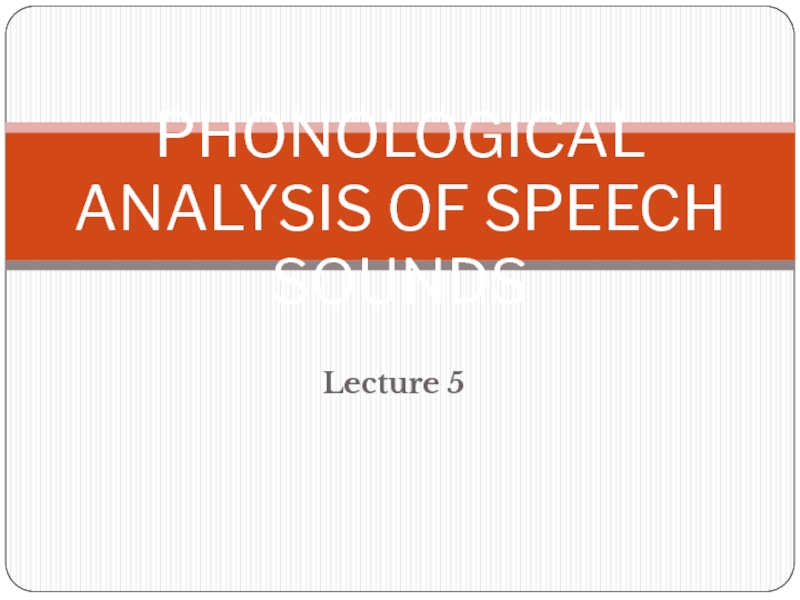
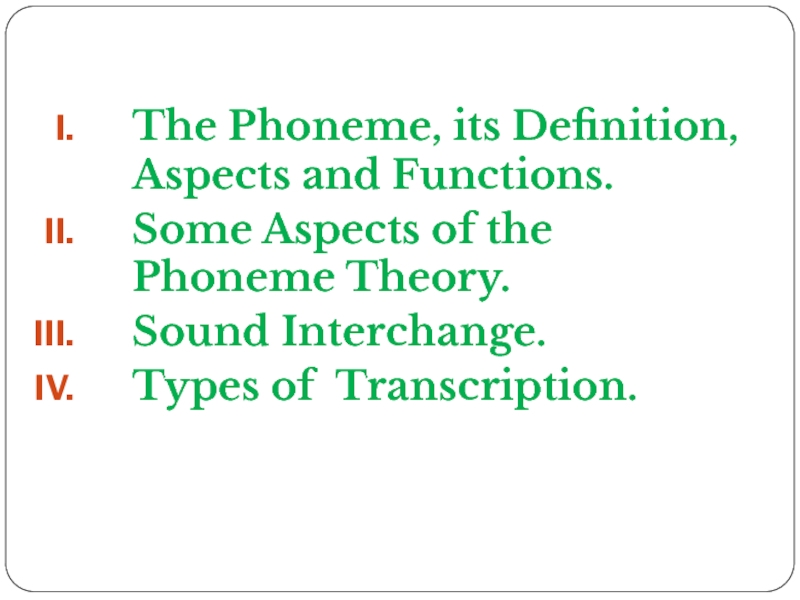
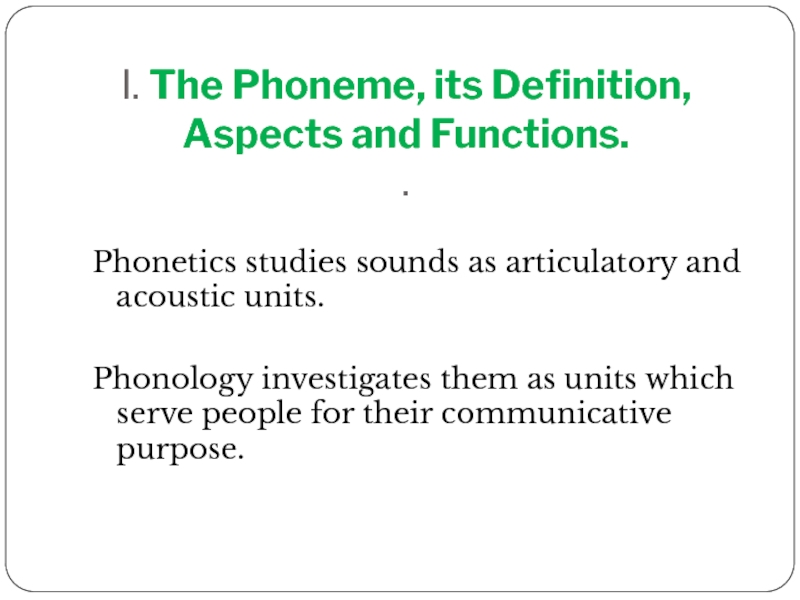
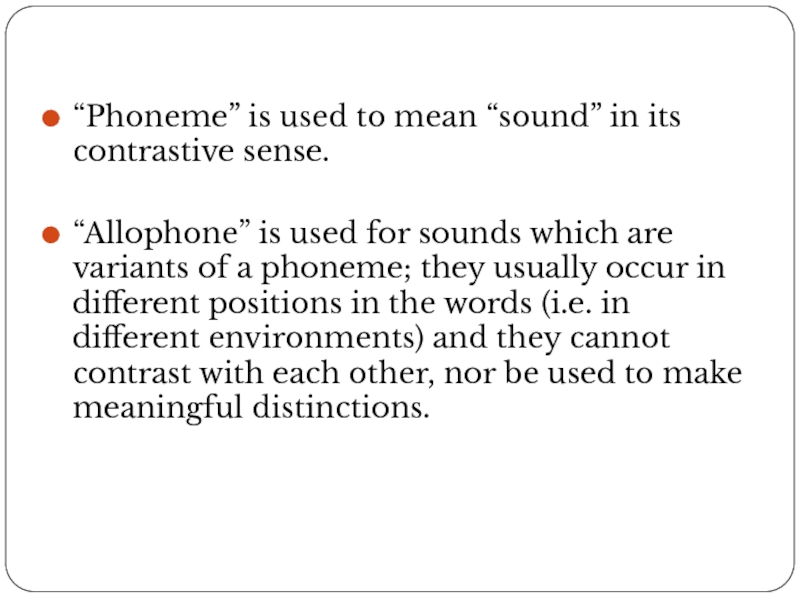
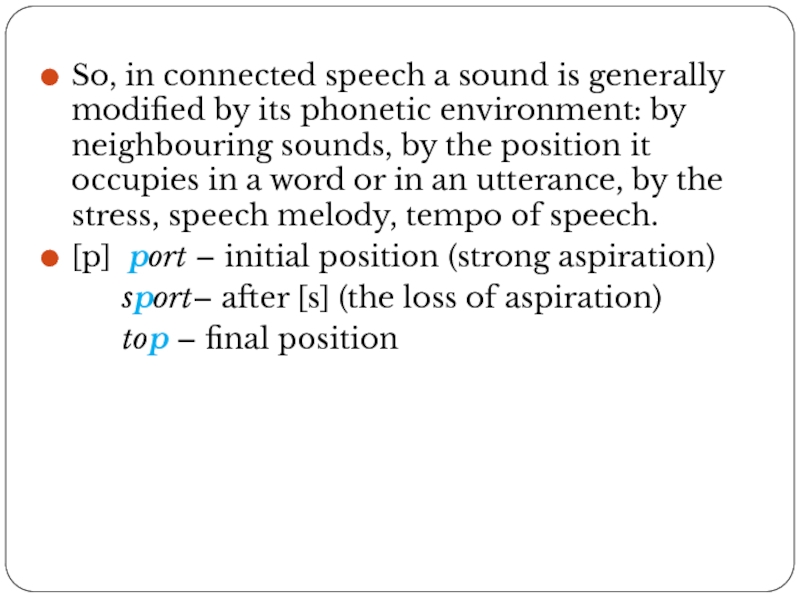
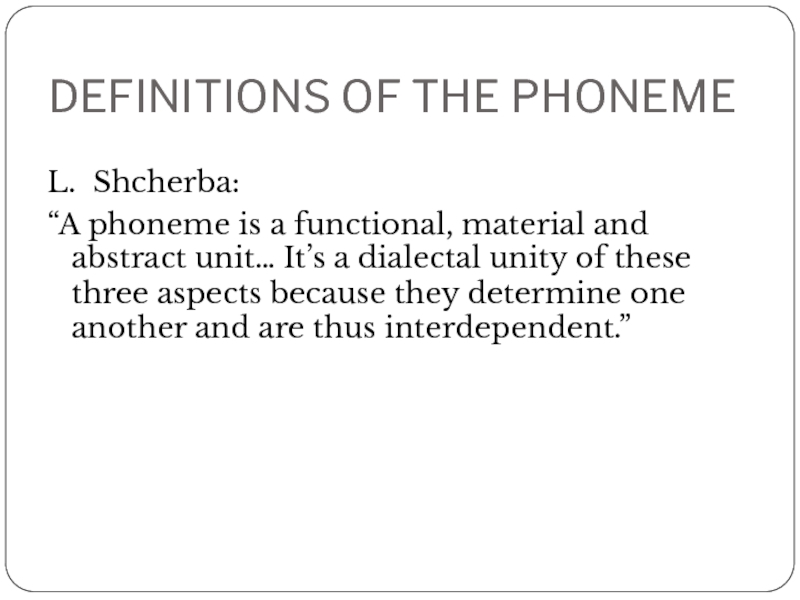
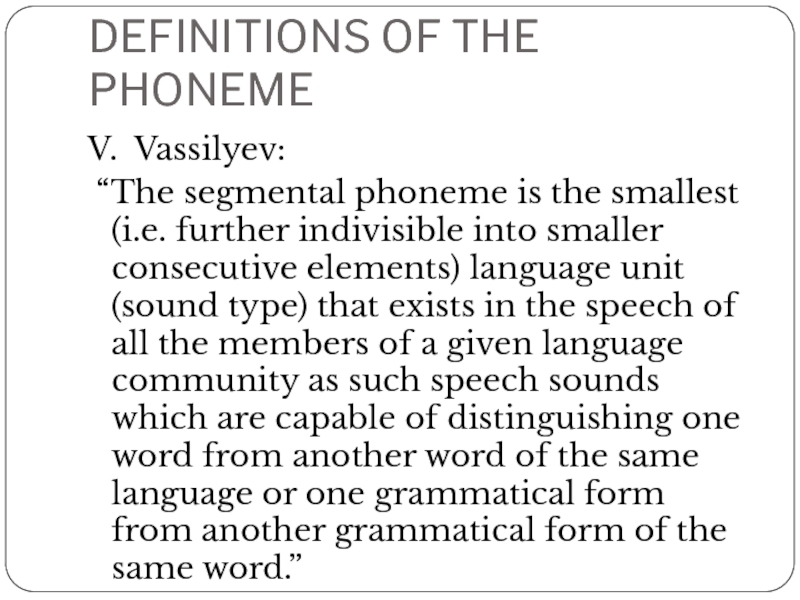
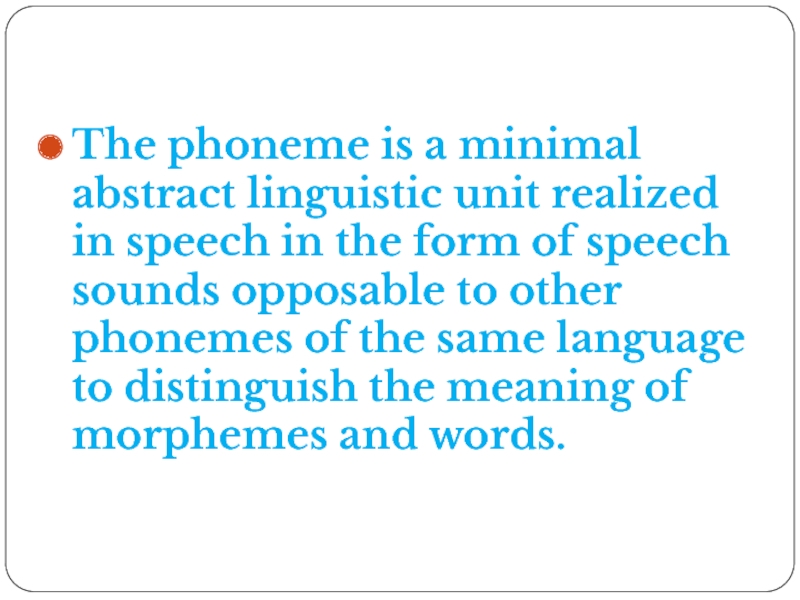
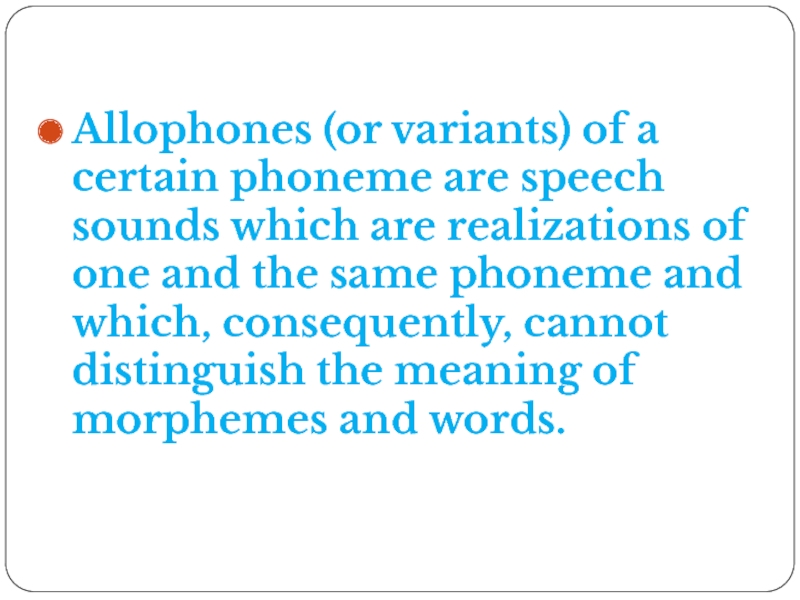
![THE PHONEME [t] and its allophonesStongly aspiratied before stressed vowels, e.g. talkNon-aspirated after [s], e.g.](/img/tmb/3/254729/6b9c119e5d26657b4e8e5acdaf327a06-800x.jpg)
![FUNCTIONS OF THE PHONEMEThe distinctive function. (a) morpheme-distinctive function: full-fully [-]-[ɪ] (b)](/img/tmb/3/254729/69d3fbdf82a05568e1522b907746e57e-800x.jpg)
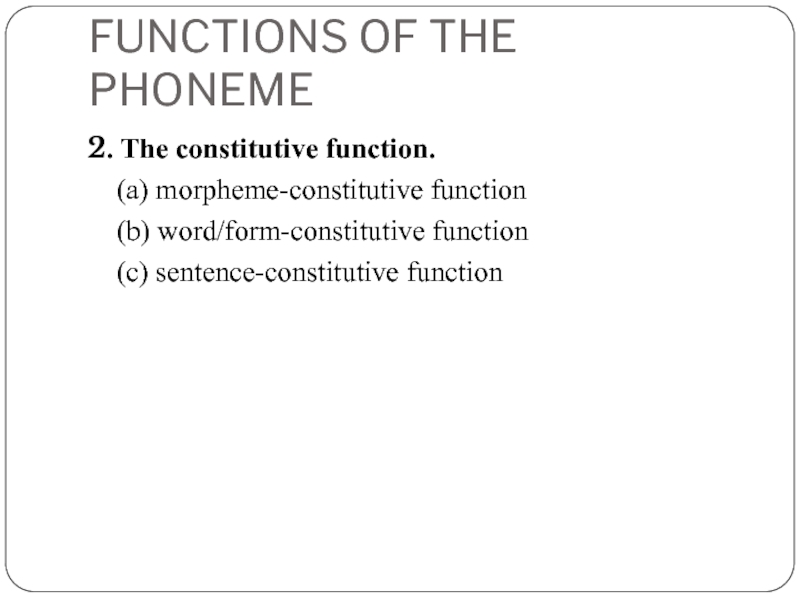
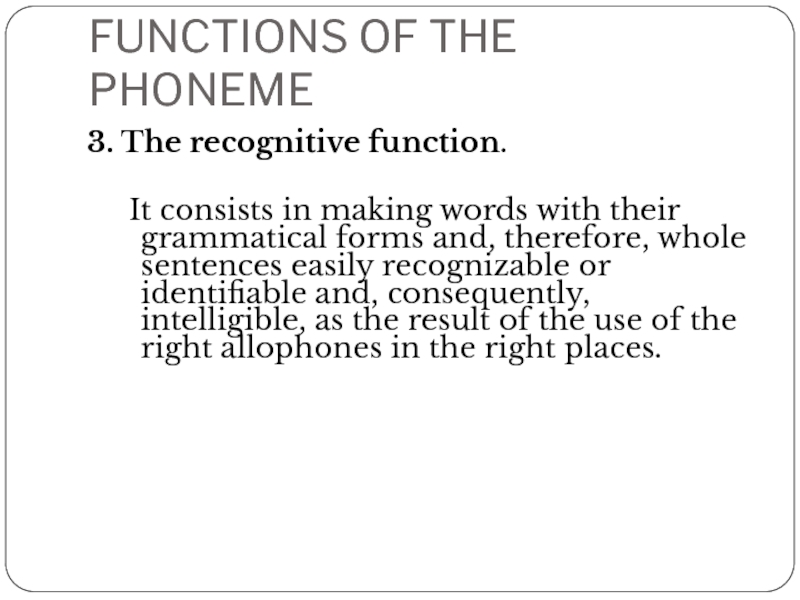
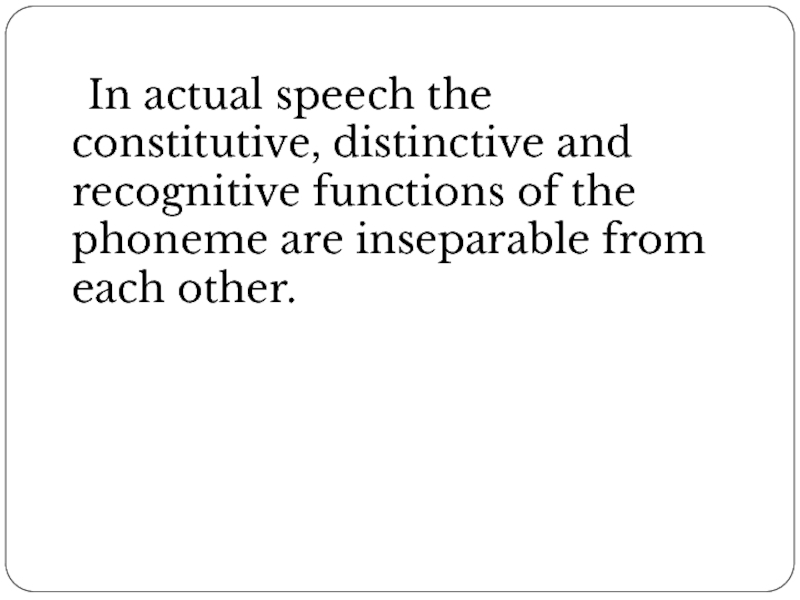
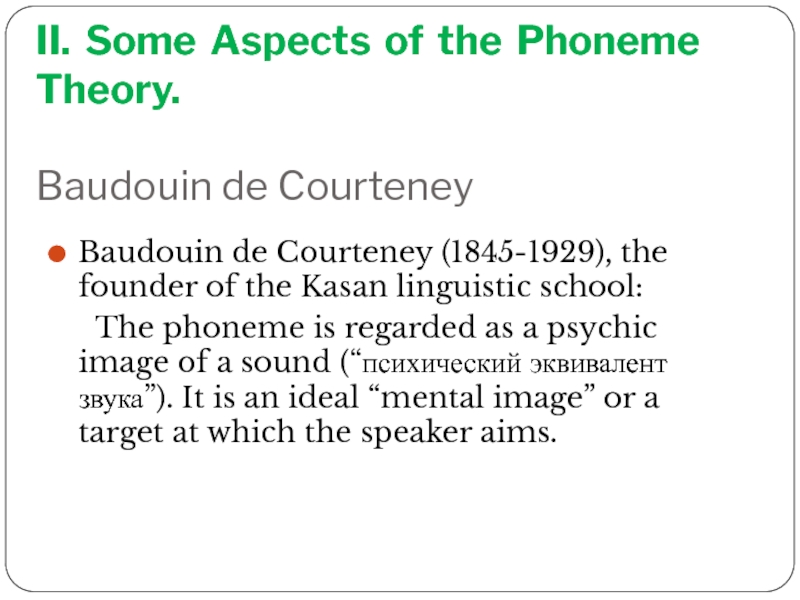
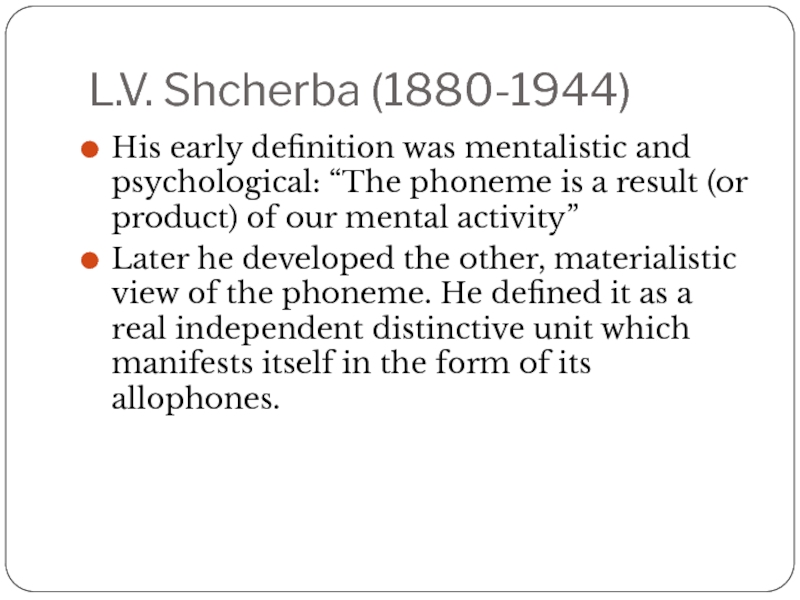
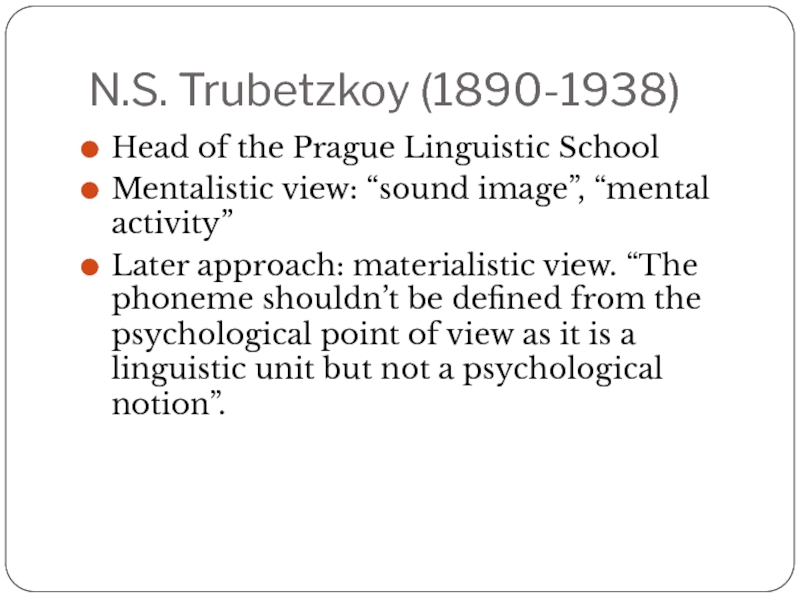
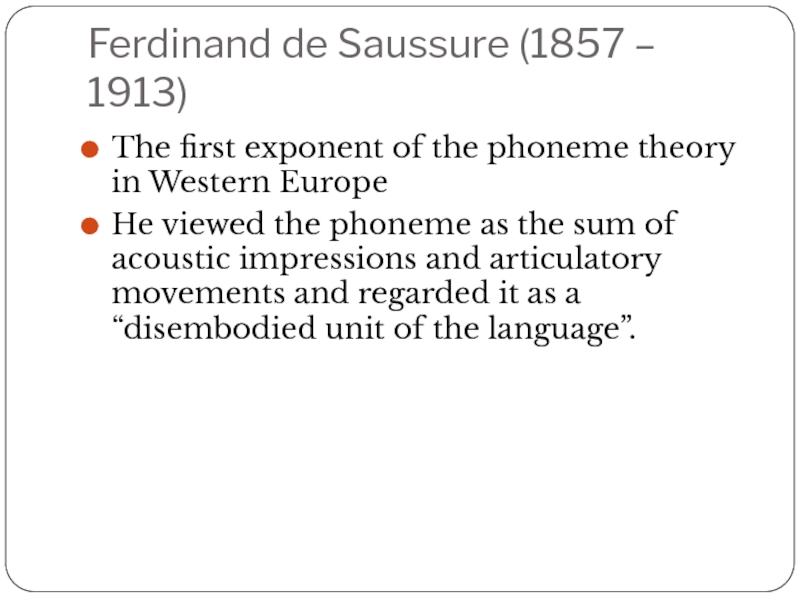
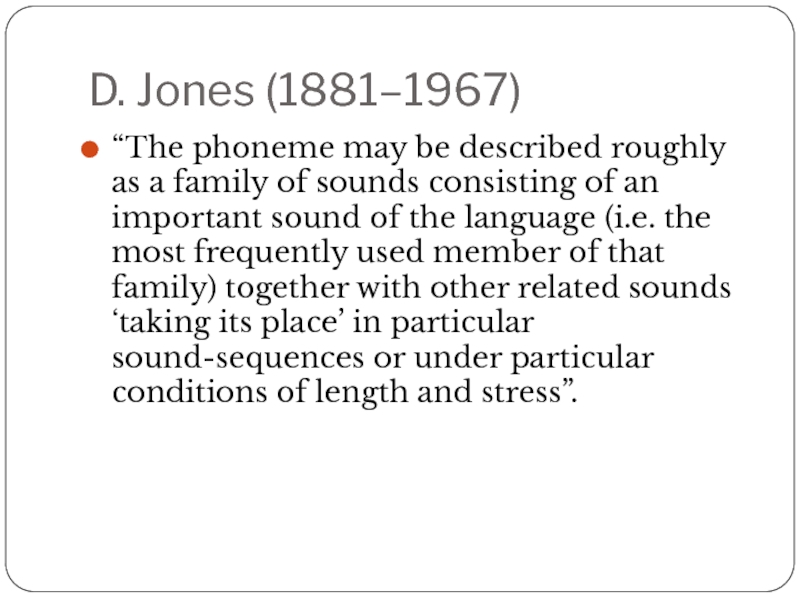
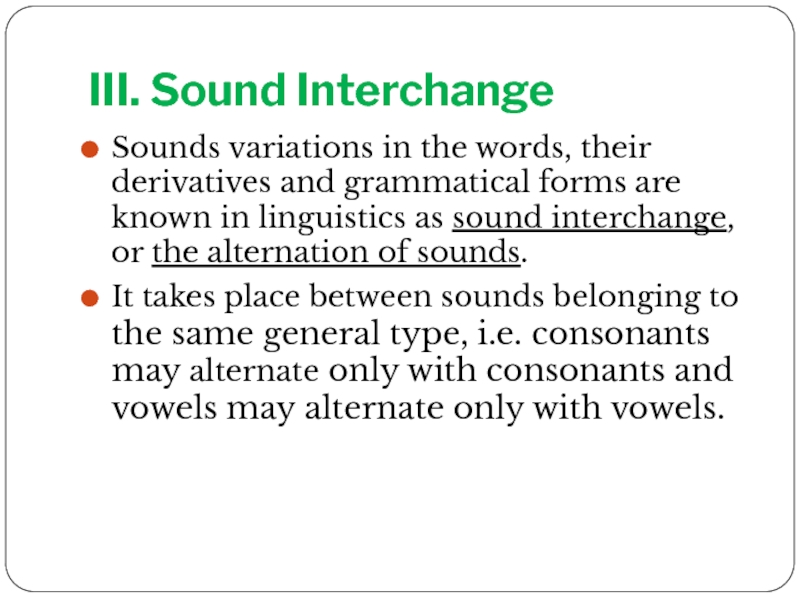
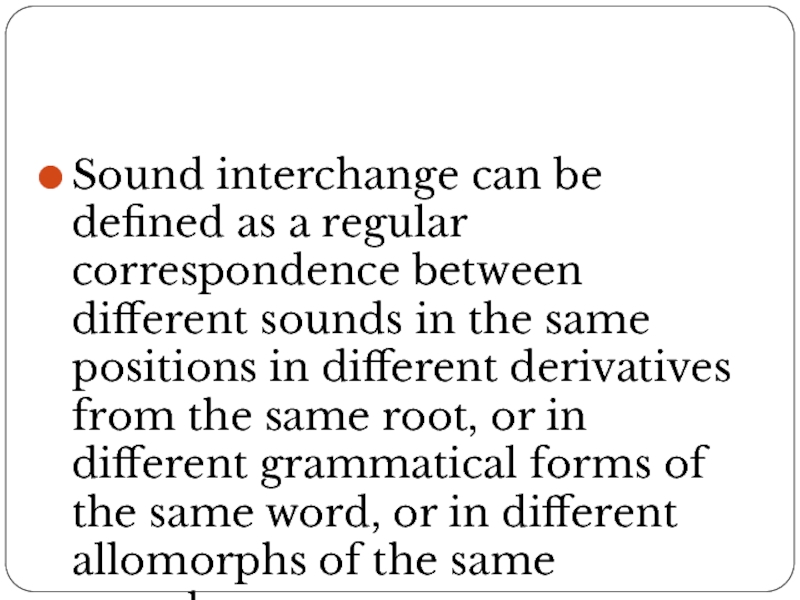
![[mæn]- [men] – the alternates are [æ]- [e] which distinguish singular and plural forms of](/img/tmb/3/254729/ad9cbecebb46ab3128b9074bda12286f-800x.jpg)
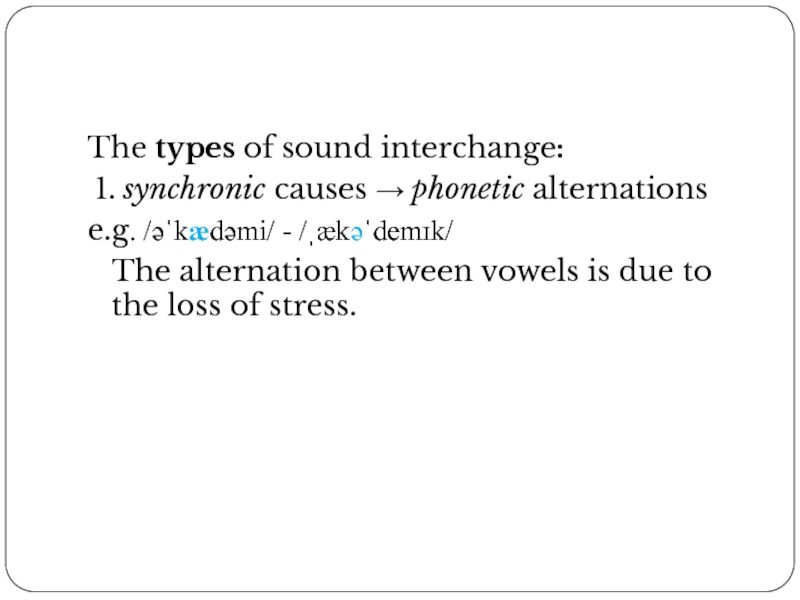
![2. Diachronic causes → historical alternations e.g. tooth – teeth [tu:ɵ]-[ti:ɵ] This interchange is](/img/tmb/3/254729/005d63e27d914e59a0e82b1a059ff5f4-800x.jpg)
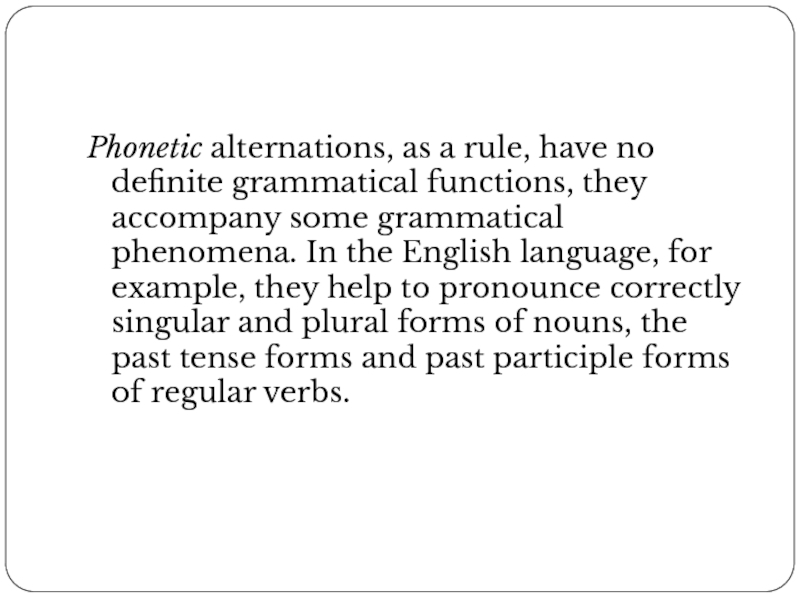
![e.g. [s] is pronounced after voiceless consonants (clocks);[z] is pronounced after voiced consonants and vowels](/img/tmb/3/254729/4a8af9ee5c2149a4db033b846666922a-800x.jpg)
![e.g. [d] is pronounced after voiced consonants and vowels (played, hugged);[t] is pronounced after voiceless](/img/tmb/3/254729/b1913fce600a48624d21b6555d6f6111-800x.jpg)
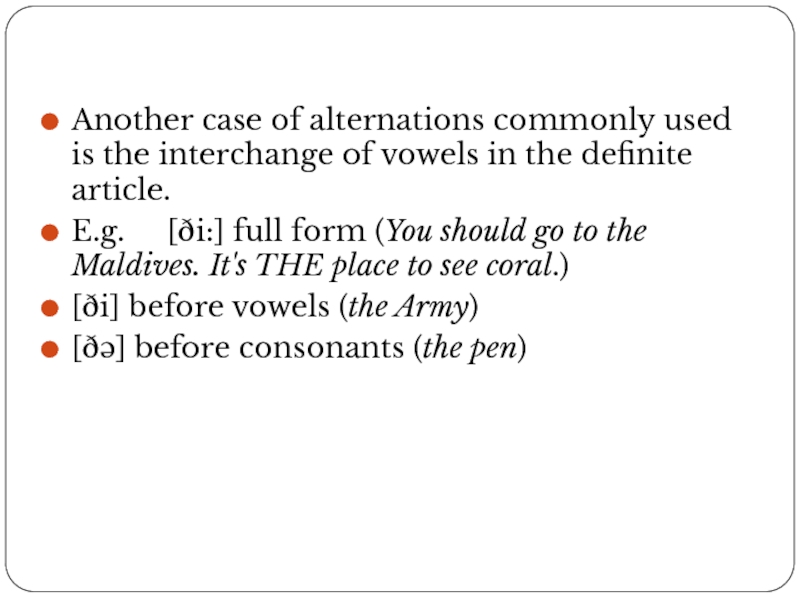
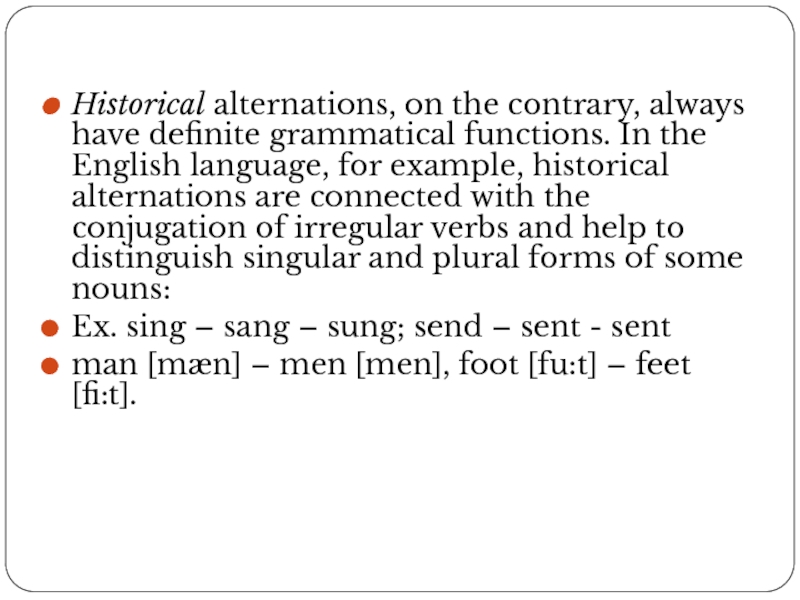
![An alternation of sounds may be combined with suffixation, e.g. [aι-ι] in [t∫aιld]-[‘t∫ιldrən]](/img/tmb/3/254729/9e883fa343046a5dac23390b95addf68-800x.jpg)
